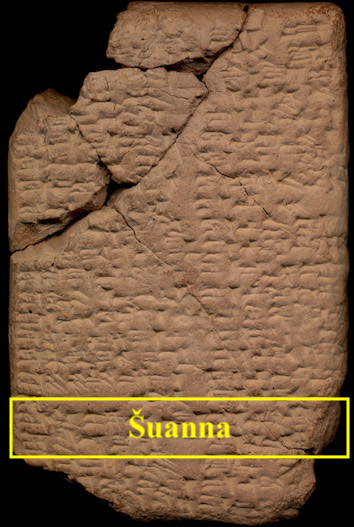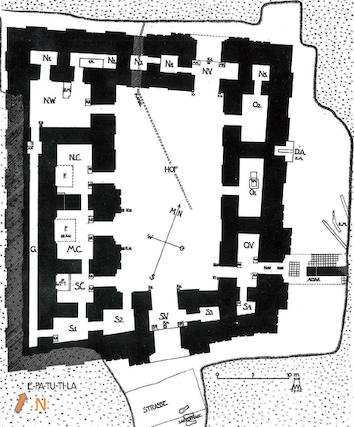Ehursagtila (temple of Ninurta at Babylon)

According to Tablet IV of the scholarly compendium Tintir = Babylon, Ehursagtila, the temple of the warrior god Ninurta, was one of the two temples situated in the Šuanna district of East Babylon; this information is confirmed by several clay cylinders of the Neo-Babylonian king Nabopolassar (r. 625–605 BC) that were discovered in its ruins. The remains of the building are now covered by earth, but the contours of its walls can still be seen.

Names and Spellings
This temple at Babylon went by the Sumerian ceremonial name Ehursagtila, which means "House Which Exterminates the Mountains." The name is attested in Tintir = Babylon Tablet IV, as well as in cultic calendars, liturgical texts, religious texts, ritual texts, and royal inscriptions of Nabopolassar (the founder of the Neo-Babylonian Empire).
- Written Forms: e₂-PA.GIN₃-ti-la; é-ḫur-sag-ti-la; é-ḫur-sag-til-la.
Note that the writing of the name e₂-PA.GIN₃-ti-la is a scholarly writing of the better-attested e₂-ḫur-sag-ti-la.
Known Builders
- Neo-Babylonian (ca. 625–539 BC)
- Nabopolassar (r. 625–605 BC)
- Nebuchadnezzar II (r. 604–562 BC)
Building History
Few details about the building history of the Ninurta temple at Babylon are known, especially before the Neo-Babylonian Period. According to an Akkadian inscription written on single-column clay cylinders found inside the temple, Nabopolassar, the founder of the Neo-Babylonian Empire, completely rebuilt Ehursagtila, whose construction he claims had been left unfinished by a former, unnamed ruler. The relevant passage of that text reads:
It is often assumed that one of the late Neo-Assyrian kings, either Esarhaddon (r. 680–669 BC) or Ashurbanipal (r. 668–ca. 631 BC), might have been the earlier king mentioned in the above-cited passage, although this cannot be proven conclusively given the lack of contemporary textual evidence. Nabopolassar's son and immediate successor Nebuchadnezzar II also worked on Ehursagtila, as is evident from bricks bearing inscriptions of his built into the floors. Those texts, however, provide no information about that Neo-Babylonian king's work on Ninurta's temple. It is possible that some of the Nebuchadnezzar bricks used in the uppermost-attested floor were put there during a phase of construction that took place after Nebuchadnezzar's reign and, thus, Ehursagtila might have been worked on by one of that king's successors — for example, Neriglissar (r. 555–556 BC) or Nabonidus (r. 555–539 BC) — since that temple was in use to at least the beginning of the second century BC.

Excavation plan of the Ninurta temple at Babylon. Image from R. Koldewey, Die Tempel von Babylon und Borsippa, pl. 7.
Archaeological Remains
The substantial remains of Ehursagtila were excavated by the Deutsche Orient-Gesellschaft (DOG) in 1901 under the direction of Robert Koldewey. The ruins of this building, which are located in the area of Babylon known today as Ischin Aswad, were identified as belonging to the Ninurta temple principally from several inscribed clay cylinders of Nabopolassar buried under one of its floors. This confirms the information provided in Tintir = Babylon Tablet IV, which stated that Ehursagtila was located in the Šuanna district of East Babylon. Although the temple is now covered by earth, the contours of its walls can still be seen.
This small temple measured 40×45 m (1,780 m²) and had eighteen rooms centered around an unusually-large central courtyard (Hof). The temple had three cellas (Rooms NC, MC, and SC); the middle one, which was the most elaborately decorated, belonged to Ninurta. The foundations and walls were constructed from unbaked bricks. The walls were decorated with white lime-gypsum plaster and black bitumen. The walls were 2.8 m thick; they are estimated to have been 10 m tall. Most of the floors, including the one in the courtyard, were covered with asphalt. Two plastered, unbaked mudbrick altars were unearthed in front of the main entrance, which was located in the eastern façade; secondary entryways into the temple were located in the north and south walls.
Several clay cylinders of Nabopolassar were found under the floor of Level 1 and bricks bearing inscriptions of Nebuchadnezzar II were used to pave the floors of Levels 2–4, thus, providing evidence for these two Neo-Babylonian kings working on Ehursagtila. An archive of 550 tablets was excavated by German archaeologists in Rooms S3 and S4, in the southeastern part of the temple; the texts are dated between Nebuchadnezzar II's sixth regnal year (599 BC) to Darius I's eighteenth year as king (504 BC).
Further Reading
- George, A.R. 1992. Babylonian Topographical Texts (Orientalia Lovaniensia Analecta 40), Leuven, pp. 313–314.
- George, A.R. 1993. House Most High. The Temples of Ancient Mesopotamia (Mesopotamian Civilizations 5), Winona Lake, p. 102 no. 489.
- Koldewey, R. 1911. Die Tempel von Babylon und Borsippa (Wissenschaftliche Veröffentlichungen der Deutschen Orient-Gesellschaft 15), Leipzig, pp. 25–33 and pls. 6–7.
- Koldewey, R. 1990. Das wieder erstehende Babylon, fifth edition (edited by B. Hrouda), Munich, pp. 221–227.
- Pedersén, O. 2021. Babylon: The Great City, Münster, pp. 190–193.
Banner image: annotated plan of the ruins in the area of the Šuanna district of East Babylon, including Ehursagtila (left); photograph of the area of the ruins of the Ninurta temple taken in January 2018 (middle); digital reconstruction of Ehursagtila (right). Image created by Jamie Novotny from Koldewey, Das wieder erstehende Babylon, fifth edition, fig. 256; and O. Pedersén, Babylon: The Great City, p. 190 fig. 4.49 and p. 193 fig. 4.53.
Jamie Novotny & Joshua Meynell
Jamie Novotny & Joshua Meynell, 'Ehursagtila (temple of Ninurta at Babylon)', Babylonian Temples and Monumental Architecture online (BTMAo), The BTMAo Project, a sub-project of MOCCI, [http://oracc.org/btmao/Babylon/TemplesandZiggurat/Ehursagtila/]